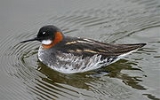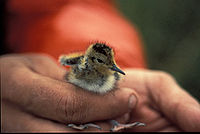
Red-necked Phalarope
Encyclopedia
The Red-necked Phalarope, Phalaropus lobatus, is a small wader
. This phalarope
breeds in the Arctic
regions of North America
and Eurasia
. It is migratory
, and, unusually for a wader, winters at sea on tropical oceans.
Red-necked Phalarope is about 18 cm (7 in) in length, with lobed toes and a straight, fine bill. The breeding female is predominantly dark grey above, with a chestnut neck and upper breast, black face and white throat. The breeding male is a duller version of the female. They have lobed toes to assist with their swimming. Young birds are grey and brown above, with buff underparts and a black patch through the eye. In winter, the plumage is essentially grey above and white below, but the black eyepatch is always present. They have a sharp call described as a whit or twit.
The typical avian sex roles are reversed in the three phalarope species. Females are larger and more brightly coloured than males. The females pursue males, compete for nesting territory, and will aggressively defend their nests and chosen mates. Once the females lay their eggs, they begin their southward migration, leaving the males to incubate the eggs and look after the young. Three to seven eggs are laid in a ground nest near a marsh
y area. The young mainly feed themselves and are able to fly within 20 days of birth.
 When feeding, a Red-necked Phalarope will often swim in a small, rapid circle, forming a small whirlpool. This behaviour is thought to aid feeding by raising food from the bottom of shallow water. The bird will reach into the center of the vortex with its bill, plucking small insect
When feeding, a Red-necked Phalarope will often swim in a small, rapid circle, forming a small whirlpool. This behaviour is thought to aid feeding by raising food from the bottom of shallow water. The bird will reach into the center of the vortex with its bill, plucking small insect
s or crustacean
s caught up therein. On the open ocean, they are often found where converging currents produce upwellings. During migration, some flocks stop over on the open waters at the mouth of the Bay of Fundy
to take advantage of food stirred up by tidal action.
Almost all of the nonbreeding season is spent in open water. This species is often very tame and approachable.
The Red-necked Phalarope is one of the species to which the Agreement on the Conservation of African-Eurasian Migratory Waterbirds (AEWA
) applies.
, which lie on the extreme edge of its world range. The most reliable place for them is the Shetland Isles, particularly the Loch of Funzie on Fetlar
, with a few birds breeding elsewhere in Scotland in the Outer Hebrides
(e.g. at Loch na Muilne, where a "phalarope watchpoint" has been set up) and sometimes the Scottish Mainland in Ross-shire
or Sutherland
. They have also bred in western Ireland
, although there are very few breeding records since the 1970s.
Wader
Waders, called shorebirds in North America , are members of the order Charadriiformes, excluding the more marine web-footed seabird groups. The latter are the skuas , gulls , terns , skimmers , and auks...
. This phalarope
Phalarope
A phalarope or wadepiper is any of three living species of slender-necked shorebirds in the genus Phalaropus of the bird family Scolopacidae. They are close relatives of the shanks and tattlers, the Actitis and Terek Sandpipers, and also of the turnstones and calidrids...
breeds in the Arctic
Arctic
The Arctic is a region located at the northern-most part of the Earth. The Arctic consists of the Arctic Ocean and parts of Canada, Russia, Greenland, the United States, Norway, Sweden, Finland, and Iceland. The Arctic region consists of a vast, ice-covered ocean, surrounded by treeless permafrost...
regions of North America
North America
North America is a continent wholly within the Northern Hemisphere and almost wholly within the Western Hemisphere. It is also considered a northern subcontinent of the Americas...
and Eurasia
Eurasia
Eurasia is a continent or supercontinent comprising the traditional continents of Europe and Asia ; covering about 52,990,000 km2 or about 10.6% of the Earth's surface located primarily in the eastern and northern hemispheres...
. It is migratory
Bird migration
Bird migration is the regular seasonal journey undertaken by many species of birds. Bird movements include those made in response to changes in food availability, habitat or weather. Sometimes, journeys are not termed "true migration" because they are irregular or in only one direction...
, and, unusually for a wader, winters at sea on tropical oceans.
Red-necked Phalarope is about 18 cm (7 in) in length, with lobed toes and a straight, fine bill. The breeding female is predominantly dark grey above, with a chestnut neck and upper breast, black face and white throat. The breeding male is a duller version of the female. They have lobed toes to assist with their swimming. Young birds are grey and brown above, with buff underparts and a black patch through the eye. In winter, the plumage is essentially grey above and white below, but the black eyepatch is always present. They have a sharp call described as a whit or twit.
The typical avian sex roles are reversed in the three phalarope species. Females are larger and more brightly coloured than males. The females pursue males, compete for nesting territory, and will aggressively defend their nests and chosen mates. Once the females lay their eggs, they begin their southward migration, leaving the males to incubate the eggs and look after the young. Three to seven eggs are laid in a ground nest near a marsh
Marsh
In geography, a marsh, or morass, is a type of wetland that is subject to frequent or continuous flood. Typically the water is shallow and features grasses, rushes, reeds, typhas, sedges, other herbaceous plants, and moss....
y area. The young mainly feed themselves and are able to fly within 20 days of birth.

Insect
Insects are a class of living creatures within the arthropods that have a chitinous exoskeleton, a three-part body , three pairs of jointed legs, compound eyes, and two antennae...
s or crustacean
Crustacean
Crustaceans form a very large group of arthropods, usually treated as a subphylum, which includes such familiar animals as crabs, lobsters, crayfish, shrimp, krill and barnacles. The 50,000 described species range in size from Stygotantulus stocki at , to the Japanese spider crab with a leg span...
s caught up therein. On the open ocean, they are often found where converging currents produce upwellings. During migration, some flocks stop over on the open waters at the mouth of the Bay of Fundy
Bay of Fundy
The Bay of Fundy is a bay on the Atlantic coast of North America, on the northeast end of the Gulf of Maine between the Canadian provinces of New Brunswick and Nova Scotia, with a small portion touching the U.S. state of Maine...
to take advantage of food stirred up by tidal action.
Almost all of the nonbreeding season is spent in open water. This species is often very tame and approachable.
The Red-necked Phalarope is one of the species to which the Agreement on the Conservation of African-Eurasian Migratory Waterbirds (AEWA
AEWA
The Agreement on the Conservation of African-Eurasian Migratory Waterbirds is the largest of its kind developed so far under the Bonn Convention. It was concluded on 16 June 1995 at The Hague, the Netherlands and entered into force on 1 November 1999 after the required number of at least fourteen...
) applies.
In Britain and Ireland
The Red-necked Phalorope is a rare and localised breeding species in the British IslesBritish Isles
The British Isles are a group of islands off the northwest coast of continental Europe that include the islands of Great Britain and Ireland and over six thousand smaller isles. There are two sovereign states located on the islands: the United Kingdom of Great Britain and Northern Ireland and...
, which lie on the extreme edge of its world range. The most reliable place for them is the Shetland Isles, particularly the Loch of Funzie on Fetlar
Fetlar
Fetlar is one of the North Isles of Shetland, Scotland, with a population of 86 at the time of the 2001 census. Its main settlement is Houbie on the south coast, home to the Fetlar Interpretive Centre...
, with a few birds breeding elsewhere in Scotland in the Outer Hebrides
Outer Hebrides
The Outer Hebrides also known as the Western Isles and the Long Island, is an island chain off the west coast of Scotland. The islands are geographically contiguous with Comhairle nan Eilean Siar, one of the 32 unitary council areas of Scotland...
(e.g. at Loch na Muilne, where a "phalarope watchpoint" has been set up) and sometimes the Scottish Mainland in Ross-shire
Ross-shire
Ross-shire is an area in the Highland Council Area in Scotland. The name is now used as a geographic or cultural term, equivalent to Ross. Until 1889 the term denoted a county of Scotland, also known as the County of Ross...
or Sutherland
Sutherland
Sutherland is a registration county, lieutenancy area and historic administrative county of Scotland. It is now within the Highland local government area. In Gaelic the area is referred to according to its traditional areas: Dùthaich 'IcAoidh , Asainte , and Cataibh...
. They have also bred in western Ireland
Ireland
Ireland is an island to the northwest of continental Europe. It is the third-largest island in Europe and the twentieth-largest island on Earth...
, although there are very few breeding records since the 1970s.
External links
- RSPB A to Z of UK Birds
- Red-necked Phalarope videos, photos & sounds on the Internet Bird Collection
- Image from Iceland
- eNature.com - Red-necked Phalarope
- South Dakota Birds - Red-necked Phalarope
- USGS - Red-necked Phalarope
- VIREO photo gallery - Red-necked Phalarope
- Stamps - Red Phalarope (for IcelandIcelandIceland , described as the Republic of Iceland, is a Nordic and European island country in the North Atlantic Ocean, on the Mid-Atlantic Ridge. Iceland also refers to the main island of the country, which contains almost all the population and almost all the land area. The country has a population...
) with ~world Circumpolar-Map

